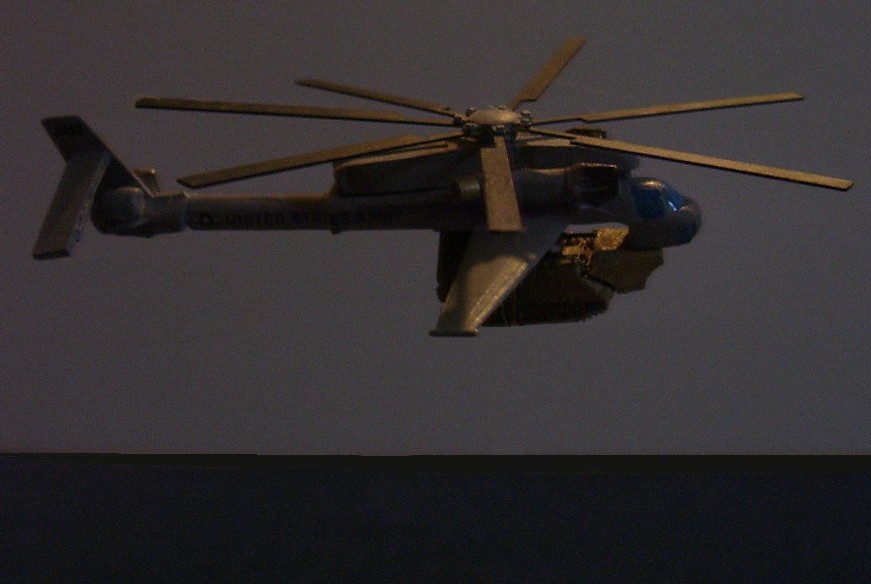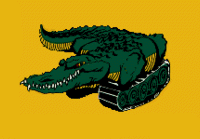 Air-Mech-Strike from Land and Sea: Airborne-Amphibious U.S. Army Combat Engineers
Air-Mech-Strike from Land and Sea: Airborne-Amphibious U.S. Army Combat Engineers
 Air-Mech-Strike from Land and Sea: Airborne-Amphibious U.S. Army Combat Engineers
Air-Mech-Strike from Land and Sea: Airborne-Amphibious U.S. Army Combat Engineers
"I don't know what the hell this logistics is that Marshall is always talking about, but I want some of it."
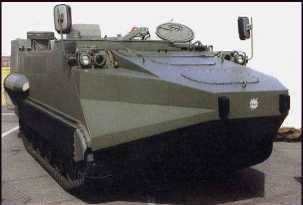
D-Day, June 6th, 1944.
Massive supporting air strikes and naval bombardments fail to clear dug-in German infantry overlooking Omaha beach...as American Soldiers struggle ashore they are torn by criss-crossing machine guns, mortars and rifle fire. Casualties mount. The beachhead is in jeopardy and General Omar Bradley considers withdrawing. Brigadier General "Norm" Cota walking up and down the beach finds a group of Army Combat Engineers and Rangers...after asking who they are, he tells them, "Lead the way...get us off this beach". The men surge forward with bangalore torpedoes and explosives, blasting a cut through the dominating rock face, and the Americans pour through, routing the Germans.
Meanwhile, to the north, the British and Canadians land but are better prepared. They have General Percy Hobart's "funnies" special track-laying tanks of the 79th Armored Division that swim ashore and provide fire support, others shot rocket mine-clearing charges and flail where land mines are with chains, others reducing and clearing obstacles without men having to charge a hail of bullets to lay a demolitions charge.
 www.youtube.com/watch?v=VSm5nBZ4X0A
www.youtube.com/watch?v=VSm5nBZ4X0A
The British and Canadians quickly move off the beach and push inland without heavy casualties using folding bicycles lead by their specialized tanks, where they then take the brunt of the German Panzer Lehr Division with Panther and Tiger tanks to take the critical cross-roads town of Caen and free the Americans to break out at St. Lo under General Patton.
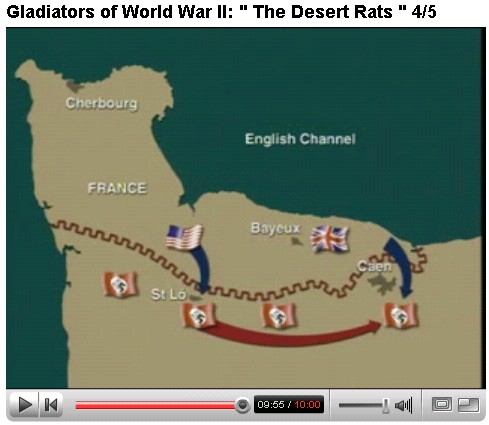
Noted U.S. Army Combat Engineer, LTC William Schneck writes;
" Based on their hard won experiences from the breaching operations conducted during the Second Battle of El Alamein [EDITOR: see "Breaching the Devil's Garden" http://handle.dtic.mil/100.2/ADA447540] and the disastrous amphibious raid on Dieppe in which the Canadians were trapped on the beach and took heavy casualties, the British organized and equipped a specialized armored division composed of nothing but special purpose armored engineer vehicles, the 79th (Hobart's Funnies). This unit was equipped with a variety of specialized vehicles that would be familiar to today's combat engineer. These included the AVRE, the Crab, and the D. D. (Duplex Drive) amphibious Sherman tank. The AVRE (Armored Vehicle, Royal Engineer) was a CEV (Combat Engineer Vehicle) based on a Churchill tank chassis equipped with a 12 inch demolition gun (called a Petard) and either an AVLB [called an SBG or Small Box Girder bridge] a fascine, or a bobbin (portable roadway). The Crab was a Sherman tank equipped with a rotating chain flail, which beat the ground ahead of it as it rotated in order to detonate mines from in front of the vehicle. "Slices" from the 79th were assigned to each of the three British beaches (Gold, Sword & Juno) and rehearsed with their respective units. For example, the 69th Brigade of the British 50th (Northumbrian) Division was led by flail tanks from the Westminster Dragoons, CEVs from the 81st squadron of the 6th Assault Regiment, Royal Engineers, and amphibious Sherman tanks from "C" Squadron, 4/7 Dragoon Guards, all of the 79th Armored Division (Hobart's Funnies). This force landed on King Sector, Gold Beach near the coastal town of La Riviere. The breaching organization in the brigade sector provided two flail tanks and four CEVs per lane with 6 breach lanes planned in the brigade sector (one per infantry company). The 69th Brigade was opposed by elements of the German's 736th Grenadier Regiment, 716th Static Division (1/3 of whom were Soviet and Polish "volunteers").
The 736th had approximately two platoons with supporting automatic weapons manning 11 concrete bunkers on the 2500m of beach in the brigade's sector. These platoons covered three belts of complex obstacles consisting of hedgehogs (2.5 kilometers) then minefields (2.5 kilometers) backed by anti-tank ditches (800m), road craters (3 large ones), wire entanglements (5 kilometers), and more minefields (another 2.5 kilometers). These minefields were composed primarily of blast anti-tank (teller) mines and bounding antipersonnel ("S") mines. The defenders were also supported by one of the famous 88mm guns, 2 artillery pieces and some mortars. Against this company minus, the British had effectively massed a reinforced brigade, achieving about a 9 to 1 advantage in manpower.
At 0521 hours, naval guns of all calibers opened fire. This naval gunfire was most accurate: it suppressed, if it did not actually destroy, many defensive positions and detonated many mines, crushed wire obstacles and disrupted land line communications; and most important of all, it dazed and stunned the defenders. At 0545, the ships began firing smoke shells as well in order to obscure the enemy's view of the landing craft as they approached the beach. As the leading wave came in, they were closely supported by special landing craft mounting 200 five-inch rockets to suppress the coastal defenses immediately on and beyond the landing area. The landings began at 0730. While infantry from the 6th Battalion/Green Howards secured the local area and suppressed nearby enemy positions, three CEVs used their demo guns against 4 of the concrete bunkers (destroying 2 and forcing the enemy to withdraw) which threatened the landing area. Then No. 1 breach team used two flail tanks to reduce the tactical minefield up to a large road crater. At this point, a CEV with an AVLB came forward and bridged the obstacle, thus opening an exit off the beach. It took the 69th Brigade less than 1 hour to create the 1200m long lane through the German obstacles and to pass the amphibious Sherman tanks through the breach to a depth of more than 1 mile to continue the assault. Four of the six breaches in the 69th Brigade sector were effective at a cost of 4 CEVs (2 to 88mm fire, 1 other knocked out, and 1 drown) and 6 flail tanks (1 to a mine and 5 bogged down)."
H-Hour, the Sava River, 1995
The U.S. Army is ordered into Bosnia to keep the warring parties apart, but they cannot cross the overflowing mighty Sava River because the bridges have been blown. Their heavy 70-ton M1 Abrams tanks and 33-ton Bradley infantry Fighting Vehicles (BFVs) designed to defend against mass Soviet tank armies with heavy armored bodies cannot swim. Their combat engineers in 11-ton M113A3 Gavins could swim but they have fallen out of practice doing so. The entire world watches via CNN as the river rises and floods away the mighty U.S. Army's bridging gear as Soldiers battle a river though unopposed by any shooting enemy. Finally, the Commander on the scene takes charge, and has CH-47D Chinook helicopters fly floating ribbon bridges and drop them directly into the water to connect them to make a bridge. The world lets out a collective sigh of relief, knowing the violence and bloodshed will finally stop as the U.S. Army rolls in.
Is the U.S. Army ready today? An Army that can't swim? Cannot airdrop?
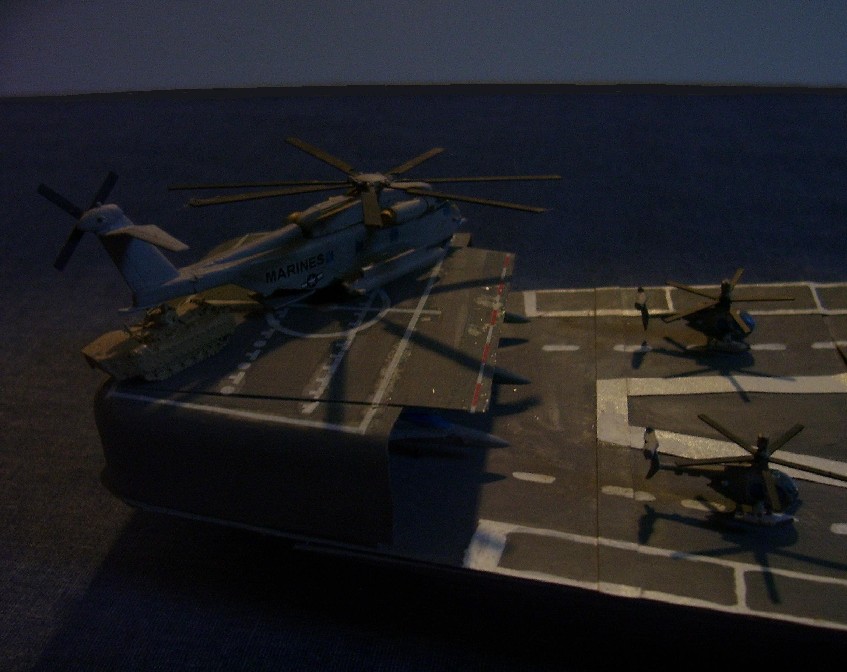
But the lessons from these and many other harrowing events where engineers have led the way have not been learned; today our Army has forgotten about maneuver and physical mechanical advantage judging by its retirement of M728 CEVs with 165mm demolition guns, the parachute-droppable Airborne Armor Battalion with M551 Sheridan light tanks which busted city walls so effectively in Panama, the cancellation of the M8 Buford Armored 105mm Gun System---its obsessed with "mouse-clicking" calls for firepower bombardment from some other service huddled in ever heavier and less mobile vehicles which cannot swim or be parachute airdropped. Refusing to parachute drop men into Afghanistan to block the terrorists from escaping across the border or to fly in tracked M113A3s from Germany to move them under armor with fire support, our Army let dangerous terrorists escape. The LAV-III "Stryker" rubber-tired armored car selected to be the "Interim Armored Vehicle" (IAV) for the IBCTs is unable to travel off-roads without getting constantly stuck, is crammed with computers so its 20-24 tons and too heavy to fly by plentiful USAF C-130 aircraft (much less parachute airdrop or move by helicopters) and cannot swim! The wheeled LAV-III/IAV cannot push a bulldozer blade. Its so heavy it can only fly two-at-a-time in the USAF's mighty C-17 jets, the exact same number as BFVs that can fly at a time--so there is no improvement in Army deployment time. Our APS-3 sealift ships loaded with heavy M1/M2s sit so low in the water that few ports in the world are deep enough for them to offload.
Like in the desperate hours of June 6th, 1944, today our Army is again "pinned down"; but this time its our own platform weight and inflexible mentalities derived because the tank was not properly developed as a Cavalry and Combat Engineer type vehicle---it needs to find a way forward to win the war on sub-national terrorism and be ready like the British 79th Armored Division was when it faces a capable Nation-State foe that shoots back in earnest.
What would General Percy Hobart do today?
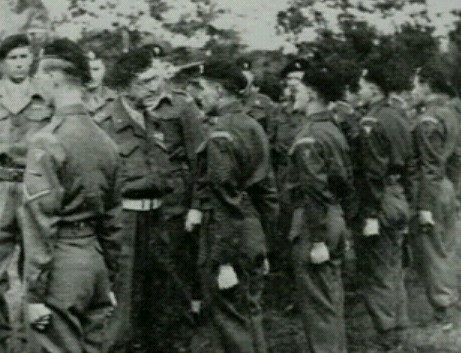
We often talk about how we admire "great men" and their deeds, now is the time to emulate them. So what would General Percy Hobart do today if he had a U.S. Army saddled with 6 division's worth of heavy defensive tanks guided by an "Armor" branch with no doctrinal battlefield functional foundation, 4 light divisions with no tracked armored vehicles at all imbued with "light-itis" hubris and billions being wasted on armored cars on an anti-Cavalry firepower bombard & occupy concoction that can neither get to a fight nor survive one if they did?
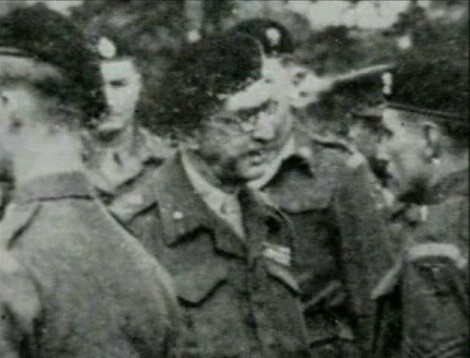
Look closely at what he did do---he found a mobility mount nobody wanted---the Churchill tank and seeing its functional potential, he added combat engineer means to it to provide the capabilities the Allies needed to breakthrough and maneuver to victory. We have fortunately the mount that can do the same thing for us today; the greatest armored fighting vehicle of all time, ever made---sitting right under our very noses---the 10.5 ton M113A3 Gavin. While more complex and "sexy" vehicles have come and gone, the sturdy M113A3 continues to serve year in and year out, because its the perfect balance of basic armor protection and low-ground pressure tracked x-country mobility ever conceived and we have 17,000 of them. We have a roughly 11-ton vehicle that can fly easily by C-130 or CH-47D/Fs and CH-53Es, be parachute airdropped, flies 5-at-a-time in C-17s and can swim across lakes and rivers. We must do what Hobart would do---create Airborne and Amphibious Light Mechanized Sappers with multiple variants of the mighty M113A3 Gavin to get off the next beach and drop zone intact and triumphant.
Light Mechanized Airborne Sappers in the Army's Light Divisions
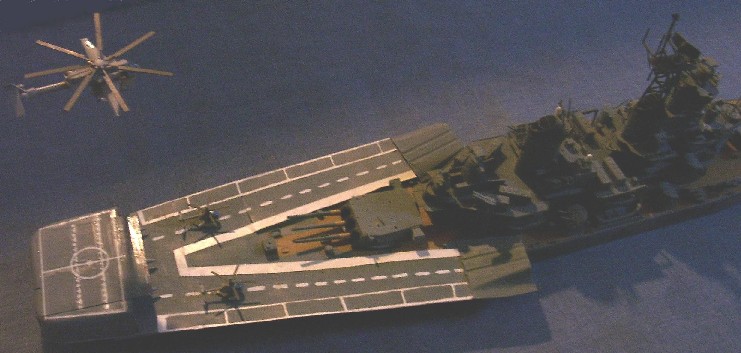
Today's Sappers in the Light Divisions do not have an armored vehicle to shoot rocket landmine clearing charges. In battle after battle at NTC and JRTC, our men are cut to pieces as they rush forward to hand-emplace charges and probe for mines. While they have rubber-tired 5-ton dump trucks that weigh 22,000 pounds, the Army's inflexible mentality refuses to supply them 11-ton M113A3 Engineer Squad Vehicles (ESVs) to armor protect them as they move forward, give them a means to shoot line charges and swim across lakes and rivers in moderate currents.
Which is heavier, 22,000 pounds of FMTV truck or 22,000 pounds of M113A3 Gavin light tracked armored fighting vehicle?
How about a ton of feathers or a ton of steel?
If you haven't already figured it out, the M113A3 Gavin weighs exactly the same as FMTV 5-ton CARGO CAPACITY trucks in use by Army light divisions, so there IS NO EXCUSE FOR THE MORE CAPABLE M113A3 Gavins being used to move infantry around in a tactically sound, armor-protected, amphibious, cross-country mobile manner with heavier firepower.
This "light-itis" of by choice driving around in unarmored rubber-tired trucks or on foot exposed to every type of fire effect imaginable must stop by outfitting at least one company in every Army Airborne, Air Assault and Light Infantry Division with 24 x M113A3 Gavin ESVs, to include RPG-proof applique' armor, thellie infared camouflage and ACAV-like gunshields. Mine clearing plows, rakes, and bulldozer blade attachments provided to do engineering work as other armies fit to their M113s, originally OUR inspired vehicle, now their current ingenuity.
LIGHT MECHANIZED SAPPER (AIRBORNE) M113A3 ESV GAVIN COMPANY
24 x Combat Engineer Company each M113A3 ESV Gavin w/.50 cal or Mk-19 40mm with gunshields
HQ
Company Commander Gavin
XO Gavin
Sapper Platoons
1st Platoon (4 x Gavins)
2nd Platoon (4 x Gavins)
3rd Platoon (4 x Gavins)
|
|
Engineer Platoon Leader + Weapons Squad M113A3 Gavin
|
1st Sapper Squad M113A3 Gavin w/demolitions, grappling hooks, mine detectors, markers
2nd Sapper Squad M113A3 Gavin w/demolitions, grappling hooks, mine detectors, markers
3rd Sapper Squad M113A3 Gavin w/demolitions, grappling hooks, mine detectors, markers
Breaching Platoon
2 x 120mm mortars to lay projected smokescreens each M1064A3 Gavin w/.50 cal or Mk-19 40mm with gunshields
4 x MICLIC rocket line charge trailers towed behind 4 x M113A3 Gavins
2 x M58 smokescreen Gavins to lay close smokescreens
2 x TOW ATGM with HEP "bunker buster" warheads; each M113A3 Gavin w/.50 cal or Mk-19 40mm with gunshields
________________________________________________________________
24 x M113A3 Gavins
The 20th Engineer Brigade (Airborne) part of the XVIII Airborne Corps would have its LMS Company's M113A3 ESVs rigged to low-velocity parachute airdrop to assist them in clearing drop and landing zones quickly against likely heavy enemy fire and forces. We can do this---its allowed to win----other third world armies can operate M113s without their logisticians going into "cardiac arrest", so can we.
The Army's CH-47D/F Chinook helicopter can lift a M113A3 ESV a short distance (under 50 km), making it a viable platform for the 101st Air Assault Division though we propose the lighter 4-ton Wiesel or 7-ton "M973A2" armored SUSV be the baseline AFV for the "Screaming Eagles".
Light Mechanized Sapper Companies with M113A3 Gavin ESVs can fly quickly by USAF aircraft to enter a conflict early through 3D movement and then shape the battlefield for the other combat arms to be victorious through decisive maneuver that encircles and collapses enemies not just mouse-clicked firepower---this is made possible by mobility, counter-mobility and survivability functions---Engineers must lead the way. Details:
www.geocities.com/lightmechanizedsappers
Light Mechanized Amphibious Sappers in the Army's Heavy Divisions
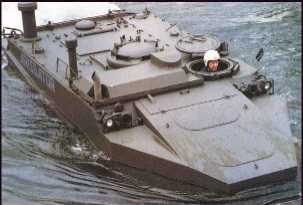
The heavy divisions of our Army must lighten up by converting a battalion in each brigade to M113A3 Gavin infantry fighting vehicles and M8 Buford armored 105mm gun system light tanks as detailed in the 2nd edition book, "Air-Mech-Strike: Asymmetric Maneuver Warfare". Combined with a robust HUMINT (not just unmanned sensors) reconnaissance capability by new-purchase Wiesel or M973A2 armored SUSV scout vehicles we would create a 3D maneuver component to the M1/M2 heavy 2D maneuver battalions in each Army heavy brigade, and the foot-mobile battalions in the light brigades to attain decisive maneuver.
The advent of computers and better communications means has created smart enemies who can network their actions, massing their forces or dispersing to evade our precision firepower through camouflage, cover, concealment, deception and deceit (C3D2) means according to the Defense Intelligence Agency (DIA). "Mouse-clicking firepower" will not corner foes that flee us; it takes ground maneuver that can prevail even in the face of enemy surveillance strike firepower capabilities that can flank, encircle and collapse enemy formations. Like Percy Hobart, we must realize that there is no "easy" open door to the enemy's jugular vein---maneuver must be earned as General DePuy warned us long ago. While our 3D maneuver forces can fly ahead to soften and collapse the enemy, our heavier 2D forces must be able to breakthrough; to do this they need armored and terrain-agile combat engineers with Sapper Tanks not just more computer accessories to hope to find an easy, painless way out.
Contrary to popular belief, the Army would not be better off trying to come up with one homogenized "medium" future combat system (FCS) platform that is neither optimized for 3D maneuver by aircraft nor hardened to breakthrough in 2D fire & maneuver. Thankfully, there are upgrades we can and should do to lighten the M1/M2s and make them use less logistics and be strategically deployable. Since they do not as currently configured fly efficiently by aircraft, the bulk of the Army's 2D heavy forces are matched by equipment sets pre-positioned on land or in sealift ships near potential world hot spots, with the expectation that their Soldiers will fly to link up with them.
U.S. Army Prepositioned Set number 3 (APS-3) will soon be complete with 19 Bob Hope-class TAKR-300 and Watson-class Large, Medium-speed Roll-On/Roll-Off Ships (LMRSs) that are preloaded with two Army armor battalions and two infantry battalion's worth of vehicles and equipment. The LMRS is a 950 x 110 x 90 (weatherdeck) (125' air draft fully loaded) ship that draws 35 feet of water and displaces the same amount as a WWII Essex-class aircraft carrier. These are very large ships limited to only a few oil supertanker ports where the water is deep enough for them to pull alongside a pier and offload their vehicles. The bottoms that actually make up the majority of the APS-3 fleet are the T-AKR 310 Watsonclass LMSRs. The '310s actually have more cargo space, and draw slightly less water (33' 6") than the Bob Hope class ships and thus still have problems finding suitable ports. When you figure that the LMSRs normally load to a 2 foot drag and MTMC-TEA wants 4 foot clearance under the lowest point of the vessel, every foot counts (channel depth no less than 40 feet, vessel "squat" not included) - another reason to load with lighter armored vehicles like the M113A3 Gavin.
The Army Science Board 1999 report; "Enabling Rapid and Decisive Strategic Maneuver for the Army After 2010" states:
"DOD shipping is too slow, takes too long to load and off-load, and requires too much water. Commercial shipping, useful to the Army, is too slow, takes too long to load and off-load, but does have more potential port access. Neither DOD nor commercial shipping has fast, austere port off-load capabilities. Lack of consistent packaging and modularization standards in military is at odds with increased commercial utilization...Sea lift has been and will continue to be the primary transportation means for large army forces, equipment, and supplies VISA is decreasing in utility due to dwindling U.S. shipping sector Army has an opportunity to improve the port to port time by 40% and load/unload time by 75%. Time window to influence High Speed Ships (HSS) opportunity is short and issues are complex. Recommendations [is] Forward to the Navy revised Army requirements for strategic sea lift to include HSS. Enter into partnership with the Navy and DOT to pursue Title XI support for HSS and support the immediate incorporation of National Defense Features (NDF) to support military cargo and austere port operations. Work with DARPA and Navy to develop technology alternatives to off-load ships rapidly in austere ports and across the shore. Advocate (Army Executive Agent) DoD-wide packaging standards consistent with best commercial industrial practices and have TRADOC develop and promulgate the associated TTPs to decrease loading time using containers, flat racks and other intermodal devices (Equally applicable to air)"
However, loaded with M1/M2s that can neither swim nor be flown by helicopters, TAKR-300s can lower barges (lighters) in the water along their side and rear ramps and slowly ferry these heavy vehicles a few at a time to shore or build a temporary pierside using many causeway sections but this takes enormous amounts of time. During this process, the unarmed civilian TAKR-300s and their civilian crews are vulnerable to myriad asymmetric enemy attacks. During the Vietnam war, the USNS Card CVE escort carrier was ferrying Army helicopters when it was attacked by VietCong frogmen while anchored in the allegedly "safe" harbor. We must not make this mistake again!
The 19 TAKR-300 LMRS ship U.S. Army APS-3 (APA) carries:
123 x M1 Abrams tanks
154 x M2 Bradley IFVs
24 x M109A6 Paladin SP guns
9 x M270 MLRS
10 x ADA Linebacker IFVs
10 x Avenger HMMWVs
40 x Armed HMMWVs
100 x M113A3 Gavin APCs
Manned by 9,800 men = 101 x C-141B airlift sorties to effect link-up
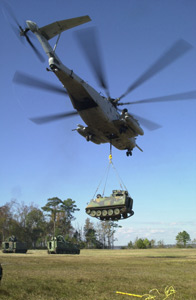
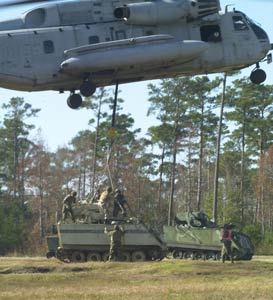
Fortunately, note that there are already over 100 x M113A3 Gavins in the APS-3 TAKR-300/310 ships that can be flown by Army CH-47D/F or marine CH-53E helicopters over sea mines to get to shore to secure a foothold if necessary, they are not the heavy armored vehicles pushing the ships down so low into the water. The helicopter transportability of the M113A3s can allow the TAKR-300/310 ships to stay farther off shore for less risk of enemy attacks. The marines could not land in Kuwait in Desert Storm because Iraqi seamines were unable to be cleared in an effective, timely manner. On the modern non-linear battlefield, there are no "safe" rear areas, the Falklands War in 1982 proved how vulnerable ships at anchor are to enemy air and missile attacks. If U.S. forces have the enemy on the run, they must rapidly deploy to finish them off or they will escape to fight another day like what took place in Iraq, Kosovo and Afghanistan. We will not have another "Desert Shield" with deep-water ports to off-load vehicles and supplies for 6 months before commencing the attack. This non-sense that we will always be welcomed ashore even during "peacetime" has to stop. Remember the USS Cole suicide boat attack that killed 17 Sailors. Let's assume nothing. Let's "get the lead out" and be ready to offload and fight ashore if needed. Many third world countries cannot control their own people (Somalia, Afghanistan) and we have to come ashore armed and ready even if the place is supposed to be "safe".
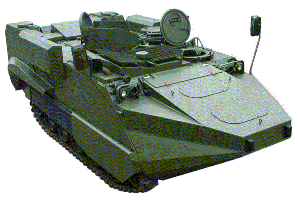
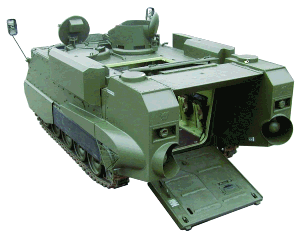
"Technology alternative" to off-load ships rapidly in austere ports and across the shore: M113A3s that swim from ship-to-shore: AmphiGavins
The 1999 Army Science Board has concluded: "Work with DARPA and Navy to develop technology alternatives to off-load ships rapidly in austere ports and across the shore". What is even more fascinating, is that there is a low-cost "technology alternative" that can make M113A3s swim to shore, solving the APS-3's TAKR-300/310 offloading problems by allowing the ships to stay in deep waters, away from would-be terrorists in small boats and along vulnerable piers/waterfronts.
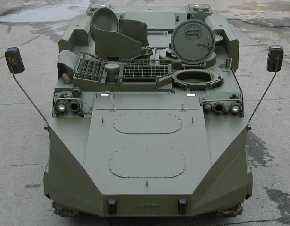
M113A3 Gavins can be fitted with an AAV-like nose, waterjets and floatation belts to be ocean-surf-zone capable and thus can swim themselves to shore just like Percy Hobart's DD amphibious Sherman tanks did in WWII. Unlike in 1944, amphibious vehicle technology has progressed to where swimming aluminum alloy armored fighting vehicles from ship-to-shore is common and safe because the vehicles float without erecting canvass screens. By being aluminum alloy armor they do not rust like steel. Amphibious M113A3 "AmphiGavins" could swim themselves to shore from 4-5 miles out, easing the offload of landing craft/lighters dramatically speeding the build-up of combat power available to the warfighting CINC to win his campaign.
Italian Surf-Zone Capable M113 Kit
1st TSG (A) EXCLUSIVE! Video clip of the AmphiGavin in action!
www.youtube.com/watch?v=1hbUusptJbs
An Italian M113A2/3 conversion by the Italian company ARIS, developed as an inexpensive alternative for the more expensive and heavier amphibious AFVs like the LVTP-7 (AAV-7) or EFV/AAAV. Besides the floatation kit and water jet propulsion system the M113 is unchanged and it can still transport the normal 11 men. 2 prototypes existed by July 1998 used for trials demonstrations. However, the light tracked amphibious AFV has capabilities its heavier cousins do not have: a triple threat capability: the M113A3 "AmphiGavin" can deploy by aircraft (helicopters and STOL C-130s), by land or from the sea!
Since roughly 50% of the APS-3's designated units have M113A3s; Combat Engineers, Medics, Mechanics, C2 units, if we modified their mounts to ocean-swim via kits, Combat Engineers would end up being first ashore with the infantry and tankers in heavy M1/M2s coming later as the lighters can shuttle them ashore at 4-6 mph. M113A3 AmphiGavin self-swim capability cuts deployment time in half because they can drive themselves out of the ship's cargo hold and enter the water simultaneously and not need to be ferried ashore a handful at a time or wait for a causeway to be built. This is just and fitting because Combat Engineers are needed to survey and clear the beach areas for trafficability for following vehicles just as Hobart's men did on D-Day so successfully. Combat Engineers lead the way!
TAKR-300/310 Sealift ships
There are two fast ways for M113A3 AmphiGavins to quickly off-load from the TAKR-300/310s; by RO/RO first placing a lighter/causeway section underneath the rear or side roll-on/roll-off ramp to float it, so the vehicles can drive off into the water or by helicopter. RO/RO would be the fastest once the initial set-up of the ramp and its floatation support is done.
Refer to MTMCTEA Pamphlet 700-4, Vessel Characteristics For Shiploading, dated August 2001. The back cover of the pamphlet shows several methods to either lighter or swim M113A3 AmphiGavins ashore. We normally terminate a Logistics- Over-The-Shore (LOTS) operation in Sea State-3 anyway, so the M113A3 AmphiGavin appears to be as capable as existing landing craft. Barges/lighters come from the RRDF "Roll-On / Roll-Off Discharge Facility". The RRDF is part of the APS-3 package carried aboard "Big Red" the FLO-FLO ship American Commorant.
Deck-craning (LO/LO) and lowering an M113A3 AmphiGavin over the side is technically feasible, but not recommended nor fast. It is difficult to check the swing of LO-LO cargo during a LOTS or in-the-stream operation and it will take at least 15 minutes for each vehicle and there are just 4 cranes. Its unlikely to get the vessel Masters' permission for helicopter sling-loads from the ship's helipad. Merchant mariners hate helicopters hovering over their decks in the first place and purely despise sling-loads suspended from them in the second. So causeways would have to be joined to create a helipad adjacent to the ship's RO/RO openings, and a refueling point for keeping the helicopters flying. The simplest solution is to make the M113A3s swim themselves to shore.
If we are doing in-the-stream operations, 7th Group will be in the thick of it. The fact is that RRDFs, Side Loading Warping Tug (SLWT; warping is an "old spice" type term that traditionally refers to moving a vessel by hauling on a line) etc. are already loaded aboard the APS-3 vessels at Diego Garcia and will be sent to wherever the LOTS operation is being conducted automatically. The stern and side ramps on all LMSRs are designed to support the weight of two 70-ton M1 tanks, so there is no technical difficulty with lowering the ramp to the level of the water and allowing the 11-12 ton M113A3 AmphiGavins to drive directly into the water, then swim to shore, assuming that the AmphiGavins are stowed so that they had access to the ramps -- not a problem. Thus, there shouldn't be a need for the RRDF under the two side and stern RO/RO ramps, but only an operational test with M113A3 AmphiGavins will give the real answer. LMRSs belong to Military Sealift Command (MSC). Up to three at a time are berthed in downtown Newport News, Virginia at the old CSX Pier #15. They berth stern-to, so that repair trucks can get up and down the ramp. All that would be required to run the M113A3 AmphiGavin test is deploying the side ramp, a low-cost operation. The M113A3 AmphiGavin could be delivered to the pier, driven up the stern ramp, down the side ramp and go for a "swim" in the James River. It might be quite a swim because all of the local piers are bulkheaded, so the AmphiGavin may have a five-mile run to the nearest re-entry point to get back on shore. A force projection experiment with the M113A3 AmphiGavin would be easy to do.
When the "Transporter" community does pre-stowage planning, they love the M113A3 Gavin, because it makes great "filler" cargo. You can stick the darn things just about anywhere. Though the air on the LMRS will circulate seven times per hour, air circulation is such a problem in real-world cargo operations that, on older ships like an FSS, you can move only one vehicle at a time in a cavernous cargo compartment, or everyone will be asphyxiated. This is where Hybrid-Electric (HE) drives could dramatically help---a M113A3 HE AmphiGavin could move by battery power, emitting no toxic smoke---to clear the entire cargo hold quickly of all vehicles simultaneously, as fast as they can be driven off. This means greater combat power for the power-projection Army.
Let's not limit ourselves to just the APS-3 vessels, either.
High Speed Sealift Catamarans
The 38-knot "Joint Venture" High Speed Sealift (HSS) HSV-XI catamaran is a hot button capability for the near-term future. The problem with large displacement hulls like the APS-3 LMSRs is finding the deep water that they need for operations. The shallow-draft Joint Venture HSV-XI catamaran has a range of about 2,400 nautical miles; so it would be great in a prepo mode in conjunction with M113A3 AmphiGavins and their onboard Soldiers to swim the combat vehicles ashore. The HSV-X1 that the Army is experimenting on right now can be configured to carry 343 x Soldiers with berthing spaces. APS-3 will have an Army watercraft capability of LCU-2000s and LSVs. In other words, there are lots of possibilities for all imaginable scenarios, to include landing on a hostile shore, but no real problems. Ships don't become a problem until you embark people for a voyage. A shiploading problem using the Army's ICODES program and the Joint Venture HSV-XI shows that up to 40 x AmphiGavins can be embarked with their PAX onto HSV-XI. This would give the Army a true amphibious capability, not a problem under Title X. The problem is to extend the range of the HSV-XI to strategic distances. This could be accomplished with a FLO-FLO ship, like the one that brought the USS Cole home. Conventional lighterage (LCU-2000s & LSVs) can use the two remaining ramps to shift the stuff that can't swim to shore.
LPD-17 flooding well-deck ships
EXCLUSIVE PROOF! Aussie M113 Gavins on U.S. Navy amphib ships!
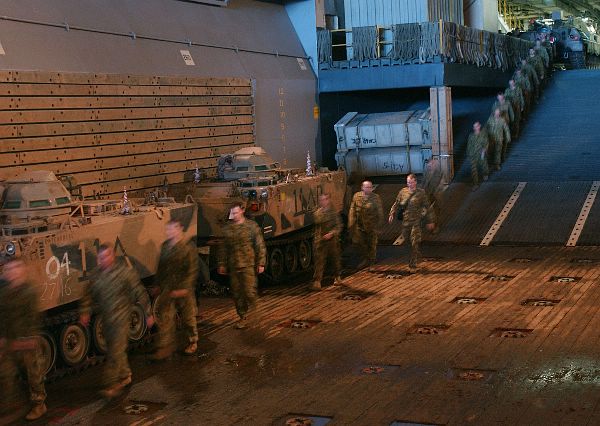
Picture source: www.navy.mil/management/photodb/webphoto/web_050613-N-7912E-001.jpg
Coral Sea (June 13, 2005) - Soldiers from the 1st Battalion Australian Regiment are led down to the well deck aboard the amphibious assault ship USS Boxer (LHD 4) for debarkation training in preparation of Talisman Sabre 2005. Talisman Sabre is an exercise jointly sponsored by the U.S. Pacific Command and Australian Defense Force Joint Operations Command, and designed to train the U.S. 7th Fleet commander's staff and Australian Joint Operations staff as a designated Combined Task Force (CTF) headquarters. The exercise focuses on crisis action planning and execution of contingency response operations. U.S. Pacific Command units and Australian forces will conduct land, sea and air training throughout the training area. More than 11,000 U.S. and 6,000 Australian personnel will participate.
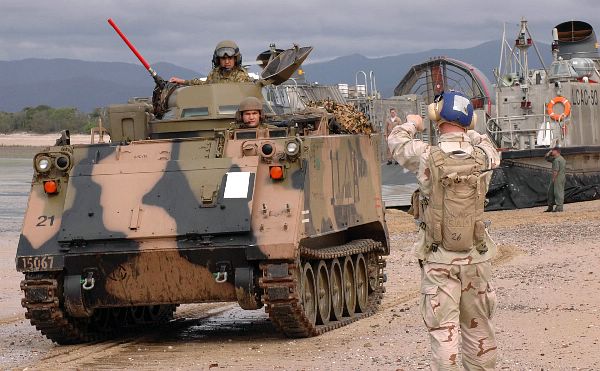
Ship-to-Shore movement techniques
Getting the folks to the LMRS is a non-problem, unless they are being used as part of an in extremis logistics-over-the-shore security establishing operation. In a passive environment, the AmphiGavin LMSC (Amphibious) Sapper are landed at a nearby airport and ferried out to the LMRS. It is the same basic deal as current APS-3 operations, but with a water taxi thrown into the mix. The LMRS's covered lifeboats can be used in lieu of a water taxi. If its a non-tactical movement, the AmphiGavins would head straight for shore individually as they splash into the water. 200 men could drive 100 x M113A3 AmphiGavins ashore.....simultaneously...
If there is an enemy threat, the AmphiGavins in the water can circle until the required number for a formation are in the water, then they can run into shore with mutual fire support from all the assembled vehicle's weaponry. If we went in with 24 x M113A3 AmphiGavins, that would give us a dismounting assault force of 152 Combat Engineers to secure the beach area who would ride inside the vehicles driven by the 48 Drivers/TCs.
LIGHT MECHANIZED SAPPER (AMPHIBIOUS) M113A3 AMPHIGAVIN COMPANY
24 x Combat Engineer Company each M113A3 ESV AmphiGavin w/.50 cal or Mk-19 40mm with gunshields
HQ
Company Commander AmphiGavin
XO AmphiGavin
Sapper Platoons
1st Platoon (4 x AmphiGavins)
2nd Platoon (4 x AmphiGavins)
3rd Platoon (4 x AmphiGavins)
|
|
Engineer Platoon Leader + Weapons Squad AmphiGavin
1st Sapper Squad AmphiGavin w/demolitions, grappling hooks, mine detectors, markers
2nd Sapper Squad AmphiGavin w/demolitions, grappling hooks, mine detectors, markers
3rd Sapper Squad AmphiGavin w/demolitions, grappling hooks, mine detectors, markers
Breaching Platoon
2 x 120mm mortars to lay far smokescreens; each M1064A3 AmphiGavin w/.50 cal or Mk-19 40mm with gunshields
4 x MICLIC rocket line charges on roof of AmphiGavins
2 x M58 smokescreen AmphiGavins to lay close smokescreens
2 x TOW ATGM with HEP "bunker buster" warheads; each M113A3 AmphiGavin w/.50 cal or Mk-19 40mm with gunshields
________________________________________________________________
24 x M113A3 AmphiGavins
Immediate Operational Capability
We are proposing modifying 100 x M113A3s into AmphiGavins and putting them into the APS-3 ships. At $200,000 per conversion this means just $20 million. 100 x AmphiGavins will need at least 100 Drivers and 100 Track Commanders = 200 men to swim the M113A3 AmphiGavin vehicles to shore simultaneously. We would designate two combat engineer companies in every heavy division as a "Light Mechanized Sapper Company (Amphibious)" to always have on-call an "APS-3 Air Alert Team" of 200 x Soldiers to do this.
The easiest way to link-up the Alert Team Drivers/TCs would be to wait for the men to fly to the APS-3 ships, embark them on a LMSR modified with extra berthing spaces for 200 men or on an accompanying Theater Support Vessel (TSV) like a LPD-17 and then set sail. Take a look at the Bob Hope Class (T-AKR 300) LMSR's bridge area and notice the large purposeless opening just below the bridge. What happened is that the naval achitects miscalculated the
aspect ratio of the original bridge design and had to raise the bridge by one deck level, leaving the gaping cavity that you see in the picture. Fill in the hole with berthing and you pick up an accommodation area that is at least 30' L x 15' H x 75' W. I suspect that our friends at the shipyards would be delighted with an excuse to cover their flub. The accommodation space could be extended abaft the bridge to the stack and up one level from abaft the bridge to the same level as the monkey island to provide additional berthing. This modification would work only on this type of LMSR (7 ships) but we only need to berth 200 men!. They got the math right on the Watson (T-AKR 310) class! The people and their gear would only weigh an additional 35 long tons, which is nothing.
Therefore, there is no reason why the APS-3 couldn't wait a few hours for a couple C-17s or C-141Bs flying in at 500+ mph to Diego Garcia and/or Saipan to deliver the required men to sail with the APS-3 TKR-300/310 ships. The modified TAKR-300/310 or TSV sailing alongside the TAKR-300/310 ships would berth the 200 Drivers, TCs who as Combat Engineers can form into squads while onboard to the mission area to act as defacto dismounted security and counter-obstacle element for a combat capability if the situation demanded it. The entire LMSC (Amphibious) unit could also be on parachute jump status and jump into a drop zone where the APS-3 ships are nearby and thus, the planes don't even have to have a runway available to airland to effect link-up (runways might be busy with USAF bombers etc.). Current large TAKR-300/310 vessels only have space for up to 12 Army personnel who maintain the cargo while the vessel is underway so one or more ships would have to be modified to berth the 200 Sappers or a TSV employed.
Whenever the designated heavy brigade is on 18-hour ready call, there will be 200 designated Drivers/TCs trained and ready to fly (and possibly jump in ahead) to link up and off-load APS-3 vehicles by swimming the M113A3 AmphiGavins and driving non-swimming vehicles onto/off lighters. The APS-3 Alert Team is simultaneously combat engineers and a robust security force; this is standard that they are ready to fight as infantry. Once Brigade Soldiers arrive to operate their assigned vehicles, the Combat Engineer Drivers/TCs reform back onto their actual M113A3 AmphiGavins as Sapper dismount squads for inland operations.
Another possible way to deliver the APS-3 Alert Team to their ships while underway at sea could be accomplished using a C-130H/J Hercules with quick-detachable floats or PantoBase skis. A regular C-130H/J can carry 92 men, but subtracting the weight of its floats, lets say it can carry 50 men. This means we'd need 4 x C-130 seaplanes to shuttle the Alert Team Drivers/TCs to APS-3 at sea. U.S. Special Operations Command has already stated an interest in a C-130 seaplane capability to clandestinely insert/extract SEAL squads flying under the curvature of the earth under enemy radar; so they could pay for the float kits using MFP 11 funds. Ships routinely embark people from water level. Lowering a gangway or Jacob's ladder from the ship to the water and running people back and forth from the C-130 seaplane in a F470 Zodiac inflatable boat with outboard motor engine manned by NAVSPECWAR Special Boat Unit coxswains would be no problem. Experienced personnel can board a moving ship, but its not wise to risk it with non-mariners.
Background: Lockheed's C-130 early Seaplane concept was to redesign the fuselage into a flying boat shape
It seems prudent that the APS-3 ship Masters would not mind V/TOL aircraft landing the 200-man APS-3 Alert Team onboard just prior to the AmphiGavin swimming off-load. In the 2nd Edition of AMS, we propose that Army UH-60 and CH-47 helicopters be upgraded into compound helicopters with wings and pusher propellers so they could range out to 1,000+ miles at 200+ mph speeds to catch up with the APS-3 ships underway at sea. Compound Army helicopters could deliver the APS-3 Alert Team just prior to the off-load, eliminating the need to embark and berth them en route.
Cutting Costs and Speeding Army Power Projection
Finally, its vital that the LMSC (Amphibious) Drivers/TCs train on swimming their M113A3 AmphiGavins at home station as their basic "Amphibious Engineer Squad Vehicle". A two company set of 48 x AmphiGavins AESVs with every Army Heavy Division, would cost; 288 x AESVs @ $200,000 = $57.6 million. Annual LMSC (Amphibious) APS-3 Air Alert crew swim certification could be done with the home-station M113A3 AmphiGavin vehicles in every Army Heavy Division likely to deploy and link-up with APS-3. The M113A3 AmphiGavins at home station could also be loaded and rapidly deployed by USAF aircraft or HSV-XI type high-speed sealift to get to the mission area. Total costs to the Army to speed APS-3 offload by 50% to increase combat power, reduce vulnerability to enemy attacks, and gain an extremis amphibious forced-entry with true ocean and inland amphibious capability in every division = $28.8 million or about the cost of 10 road-bound LAV-III/IAV armored cars that can neither fly by C-130, helicopters, swim or push a dozer blade. Another problem to keep in mind is that the Army is the only service that has to "bum a ride" to get to the war. We pay the USAF $7,570 for every hour that we fly in a C-17. The C-17 burns the normal weight of the payload (45 tons) after five hours of flying time (2,000 - 2,250 nautical miles). Something has got to change. The AmphiGavin can help fix this.
An Army transportation expert writes about flying an LAV-III/IAV IBCT by 313 x C-17 sorties:
"Then there is the hairy notion that war costs money. Our 14,000 STONs require a minimum of 311 sorties (14,000 / 45 = 311). Cycle time is (10,000/418 = 23.92 hrs + 9 hours ground time = 33 hours x 311 x $7,500 = $76,972,500 - - positioning and repositioning legs not included. So we pay the USAF $77 million just to get to the war".
In contrast, if we used lighter M113A3 and M8 AGS IAVs for the fly-away IBCTs which require only 187 x C-17 sorties to deploy instead of LAV-III/IAV IBCT's 313, we would save $47.282 million in just one IBCT one-way deployment.
33 hours x 187 x $7, 500 = $ 47, 282, 000
Not only does using lighter, more mobile, protected and armed M113A3/M8 AGS IAVs for the fly-away IBCTs make more tactical sense, it saves the Army $94.564 million for just one Kosovo-type 2-way deployment.
The $94.564 million dollars saved in money not going into the USAF's coffers because we use lighter M113A3/M8 IAVs, the Army could convert 50-100 x M113A3s into "AmphiGavins" to fill up the existing APS-3 sealift ships so they can rapidly swim ashore under their own power.
By not buying 1,500+ LAV-III/IAVs at $3 million each ($4.5 BILLION) and instead upgrading M113A3s to M113A3/IAV standard and buying some M8 AGS light tanks, the Army saves 1/2 the money ($2.25 BILLION) which can go to convert more 747s to cargo. $2,225 million divided by $10 million to convert a 747 to cargo = 222 x cargo 747s created. To be conservative, let's set aside $20 million to convert unused passenger 747s to cargo and maintain them in fly-away condition with M113A3/M8 AGS IAVs pre-loaded by lease, with civilian contract crews to fly them. This means 111 x cargo 747s that could be converted.
Since we only need 50 x cargo 747s due to airlanding MOG rates, so at $20 million each = $500 million.
$500.00 million for 50 x cargo 747 winged APS-6
- 94.56 million saved using lighter M113A3/M8 AGSs, one 66-hour deployment
________________________________________________________________
$405.44 million to pay for cargo 747s to guarantee U.S. Army strategic mobility
Cargo 747 winged "APS-6" costs subtracted from $2.25 BILLION, this leaves $1.834 BILLION to provide 30mm/Javelin autocannon turrets, band tracks, thellie camouflage, ERA armor, possibly HE drives to the 5 designated IBCT's M113A3s and convert hundreds of M113A3s to be AmphiGavins for the LMSC (Amphibious) companies in each of the Army's heavy divisions! In fact, in just 5 Kosovo-type brigade-sized air deployments, the Army will save enough money if it uses M113A3/M8 AGS IAVs to pay for 50 x cargo 747s!
Negatively considered, if the Army insists on using LAV-III/IAVs, it will have no money for autocannon turrets, infared camouflage, ERA (can't use it on the thin LAV-III's skin anyway), cargo 747s or AmphiGavins as the USAF drains its budget wallet dry at $7500/hour or $154 million every time C-17s fly an overweight LAV-III/IAV IBCT to and from a global mission! The U.S. Army will waste in USAF aircraft costs enough money during one LAV-III/IAV IBCT 2-way deployment ($96.54 million) to have bought the 82nd Airborne 32 x M8 Buford Armored 105mm Gun System light tanks.
So, if the Army got smart, cancelled the LAV-III/IAV purchases and upgraded M113A3/IAVs to much more combat capabilities than a thin box on rubber tires with a grenade machine gun with a measly 48 rounds, bought some M8 Buford AGS light tanks and converted and leased a 50 x cargo 747 "APS-6" and loaded AmphiGavins for use in APS-3 sealift to get its vehicles to the global scene faster using just a modest amount of USAF flights to transport the men to the land ISB and TAKR-300/310 LMSR ships at sea, it would save millions of taxpayer dollars and not be vulnerable to enemy anti-access strategies.
Tactical Benefits for the Army inland
The 100 x M113A3 AmphiGavins swimming ashore from the APS-3 sealift ships should be also viewed as a "light mech" force package for the Mech-Infantry to force-an-entry and for inland missions in terrains like in SEA where the M1/M2s will simply not be mobile; greatly improving the versatility of the Army force using the APS-3 set. Those that would have used the M113A3s use HMMWV trucks instead. Consider all the destroyed bridges in Afghanistan; how will the Army's LAV-III/IAVs, M2/M3 Bradleys or M1 tanks (if they were in-country) get by them? In contrast, M113A3 AmphiGavins could go across and even UP RIVERS with confidence and boldness to hunt down remnants of al Queda terrorists.
APS-3 Sliding Scale of Ground Vehicle Mobility Options to get ashore
HARDEST
/\
| 70-ton M1 Heavy Tanks
| 33-ton M2 Medium Infantry Fighting Vehicles
| 11-ton M925 or FMTV trucks (2.5 or 5-ton capacity)
| 3-ton M998 HMMWV trucks
| 11-ton M113A3 AmphiGavin ocean-swimming Infantry Carriers
\/ Walking Soldiers
EASIEST
If its a desert environment, everybody can probably use all vehicle types per TOE. However, in mobility restricted terrains like in SEA, then the M1s stay onboard and everything else goes ashore etc. as the situation dictates. The Commander can chose which vehicles to operate as the environment will allow.
How can we speed non-swimming vehicles like the M1/M2s ashore?
As stated before the Army could buy a LPD-17 ship to berth the Combat Engineers who would swim the AmphiGavins ashore and possibly operate LCACs to speed non-swimming vehicles like the M1/M2s ashore. A less costly option would be to switch a couple slow LCU-2000 landing craft for LCACs on the leased FLO-FLO ship and berth the Navy crews there. The next problem is getting the LCAC to operate from the RRDF barges.
While a LCAC can fly over a 4 foot obstacle, its best to have the RRDF have a gradual ramp edge for it to land on so the non-swimming vehicles can drive onto the LCAC. The CDI Corporation has done pioneering work developing an Air Cushion Vehicle Landing Platform or ACV-LAP derived from RRDF barges to get a LCAC interface. The Army has all the parts it needs to configure an ACV-LAP to operate from the side RO/RO ramps for LCACs to speed M1/M2s and the other non-swimming ground vehicles ashore at 30+ mph over the water on air cushions. The AmphiGavins would speed themselves ashore from the stern ramp by swimming or helicopter sling-loading.
The AmphiGavin and ACV-LAP combination means Army APS-3 forces can offload anywhere in the world despite deep water port availability or enemy anti-access strategems.
Reconfigure the APS-3 Sealift Loads into a Brigade Combat Team?
We could also fully upgrade the M113A3 AmphiGavins like Colonel Douglas MacGregor's Light Recon Strike Group proposal's "Light Strike Vehicle" to support M1 heavy tanks or to an all-M113A3/IAV-like force with multiple variants; Infantry, Mobile Gun System, Combat Engineer, ATGM, SP field artillery, Air Defense Artillery, Recon etc. The M113A3 AmphiGavin is heavy enough so that the LMSR will weigh out before it cubes out, a problem with using only one type of cargo. But 1,350 x M113A3 AmphiGavins is a reasonable estimate of the total number that could theoretically be placed on board. Think of the LMSR as a 7-acre "parking garage".
Another option would be to view all of the APS-3's M113A3 AmphiGavins as a separate transportation unit Tracked Assault Battalion (TAB) as was once done in the 1950s with the Pentomic divisions and updated by LTC Mike Robel in 1989 as a way to solve the foot-mobile Light Infantry Division's lack of armored mobility, protection and firepower:
www.geocities.com/equipmentshop/robelm113tab.htm.
Thus, the Army's Light Infantry Divisions could link up with APS-3 sealift and utilize its vehicles not just Army Heavy Divisions.
INFANTRY M113A3 AMPHIGAVIN RIFLE COMPANY
14 x Rifle Company each M113A3 AmphiGavin w/.50 cal or Mk-19 40mm with gunshields
HQ
Company Commander AmphiGavin
XO AmphiGavin
Rifle Platoons
1st Platoon (4 x AmphiGavins)
2nd Platoon (4 x AmphiGavins)
3rd Platoon (4 x AmphiGavins)
|
|
Platoon Leader + Weapons Squad AmphiGavin
1st Rifle Squad AmphiGavin (9 dismounting infantrymen)
2nd Rifle Squad AmphiGavin (9 dismounting infantrymen)
3rd Rifle Squad AmphiGavin (9 dismounting infantrymen)
Weapons Platoon
6 x 120mm mortars each M1064A3 AmphiGavin w/.50 cal or Mk-19 40mm with gunshields
4 x TOW ATGM each M113A3 AmphiGavin w/.50 cal or Mk-19 40mm with gunshields
________________________________________________________________
24 x M113A3 AmphiGavins
Regardless of whether M113A3 AmphiGavins are operated by combat or sustainment troops, all need to survive if hit by a RPG, so mount applique' armor on all M113A3 AmphiGavins. All need to fight back, too. The AMS ideal is a 30mm ASP autocannon with a Javelin fire & forget ATGM in a 1-man turret or remote weapon station. The 30mm/Javelin can be easily fitted to all AmphiGavins except perhaps the M577 CP variants (roof is too high). This armament and RPG applique' armor protection is adequate for front-line combat and makes for some very lethal sustainment troops if the grunts are using M2s instead.
The Infantry Combat team of M113A3 AmphiGavins can deploy in several ways:
a. From APS-3 sealift ships
b. Direct-delivery onto the water by floatplane C-130s that come to a stop or taxi at a slow speed as the M113A3 AmphiGavin with full 9-man infantry squad or weapons suite splashes off the rear ramp
c. Conventional C-130s low-velocity parachute airdrop (LVAD) the AmphiGavins followed by heir men in swim fins, who join it in the water, derig it, and drive it ashore
d. Conventional C-130s STOL airland onto short stretches of highway and dirt/grassy fields and the M113A3 AmphiGavins roll off the rear ramp.
Foreign Army use of the M113A3 AmphiGavin concept?

United Kingdom
Studying the British Navy's newest amphibious assault ship, the HMS Ocean. You will notice it has a stern ramp which can be deployed at sea under a mexefloat powered barge. See photo below:
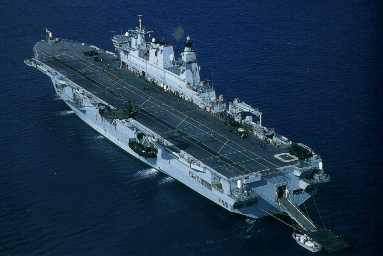
HMS Ocean Specifications:
www.naval-technology.com/projects/ocean/ocean3.html
www.geocities.com/Pentagon/Bunker/9452/ocean.htm
We propose that the RM Commandos use this stern ramp to launch ocean-going tracked armored fighting vehicles like the 46-ton AAV-7 or upgraded 11-ton M113 Gavins. Upgrading some M113s with ocean-swimming kits by ARIS SPA would be very inexpensive than trying to reopen production lines for the AAV-7 or buying the overly complex 50+ ton AAAV the U.S. marines are wasting billions on.
Perhaps even better, the British Army's Household Cavalry Regiment which already operates light tracked AFVs could acquire some M113s and upgrade them to be ocean-swim capable with the ARIS GATOR kits? The Amphibious Household Cavalry could act as a amphibious mobility mounts for attached infantry/royal marine commandos or their own scouts coming ashore from HMS Ocean, in concert with their 8-ton Scimitar family AFVs which would be sling-loaded or C-130 airland/airdropped with 16th Air Assault Brigade. Certainly beats using HMS Ocean storage space to transport 40 x Land Rover type unarmored, immobile trucks.
Dutch Royal Marines
The Dutch have a new amphibious ship called the HM RS Amsterdam which carries 32 x Leopard II heavy defensive tanks but only has a couple LCus and a mexefloat powered barge to get them ashore. If they had M113A3 AmphiGavins, these armored vehicles and Dutch Royal Marines could storm ashore en masse to seize a beah landing site and fight inland with light mechanized armored mobility and firepower.
U.S. Navy Death Spiral: Bend or Break into the "Hollow" Navy?
We are rapidly declining in the ability to keep large aircraft carriers operating. If we don't reduce from the 12 we have to 6 in my opinion we aregoing to have a "hollow" navy. This means 5,000 men on carriers with not enough airplanes by financial default.
Reduce to 6 carriers, supported by 24 small STOVL amphibious well-deck ski-jump end carriers (M113A3 AmphiGavins swim selves to shore from flooding well deck) with F-35 STOVLs and CH-53Xs (can sling-load the AmphiGavins ashore)---like the Thais have 1 model. Put 6 of the oldest carriers in a Naval Reserve "surge" capability for major nation-state wars. The large carriers will be the "nucleus" of a CVBG and operate the large C-2 Greyhound COD/E-2C Hawkeyes, F-18s (hopefully someday OA-10C SeaHogs) that can't fly from STOVL carriers.
If we don't bend here, we will break.
4 x 10,000 ton STOVL aircraft carriers instead of 1 supercarrier?
500 men to operate; 4 STOVL ski jump carriers to carry 20 x F-35 JSFs = 2,000 men = 80 aircraft at half the manning cost of 1 x 4,000 man super-carrier
World Aircraft Carriers List: Thailand
www.hazegray.org/navhist/carriers/thail.htm
Chakri Nareubet VSTOL aircraft carrier
Displacement: 11,486 tons full load Dimensions: 548.3 x 73.8 x 20.2 feet/167 x 22.5 x 6.2 meters Extreme Dimensions: 599 x 100 x 20.2 feet/182.6 x 30.5 x 6.2 meters Propulsion: CODOG: 2 diesels, 11,200 bhp, 17.2 knots; 2 LM2500 gas turbines, 2 shafts, 44,250 hp, 26.2 knots Crew:455 ship, 146 air group, 675 troops Armor: none Armament: 2 launchers for Mistral SAM, 2 12.7 mm MG Aircraft: 6 AV-8S Harriers + 4 S-70B Seahawks (or up to 18 helos) Concept/Program: A small multirole carrier, based on the Spanish Principe de Asturias class design, and built in Spain. She can serve as a disaster relief ship, troop transport/assault ship, and has accomodations for the royal family.
Design: A reduced version of Principe de Asturias, with various improvments and modernization of features. Three 6-cell Sadral SAM launchers are to be added.
Chakri Nareubet 911 Photos: [Chakri Nareubet as completed]. [Chakri Nareubet on trials].
Built by E.N. Bazan. Laid down 12 July 1994, launched 20 Jan 1996, delivered
27 March 1997, commissioned 10 August 1997. Has been largely inactive due to lack of crew and operating funds.
Another U.S. small carrier concept:
www.nps.navy.mil/tsse/files/2001.htm
This is the link to Sea Archer. Sea Archer is a small carrier design meant ot operate in groups along side Sea Lance (which seems to have become the littoral combat ship).
An Army sea transport expert writes: "Mike, It makes a lot of sense to me. Shallow draft dramatically increases mission profile."
Another analyst writes:
"I think this is workable. The Navy claims its aircraft can now do multiple sorties thanks to PGMs. In other words, PGMs are giving the aircraft less to do. Why do they insist on having supercarriers with 80-100 aircraft on board when a few bombers are more powerful than the old cold war air wings. I'll tell you why, tradition. During the cold war it took about 300 sorties to take out a given target. With PGMs, only one is needed. We must take advantage of new technology to save costs."
NEW! BattleBoxes on Container Assault Ship pictures!
With the BattleBox system its now possible to make any container ship into a "Container Assault Ship" capable of launching both air, land and sea craft as well as house Soldiers/Airmen to operate them. One application of this concept for Special Operations Forces would be to create a "Non-Linear Maneuver Brigade". Details:
www.geocities.com/airbornemuseum/nlmb.htm

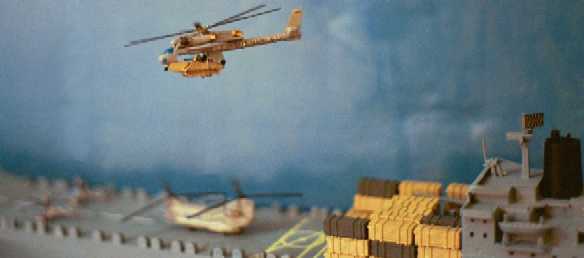
The Container Assault Ship can with its flight deck carry hundreds of ISO container BattleBoxes as well as launch V/TOL and STOVL aircraft whicle those with RO-RO ramps can simultaneously deliver amphibious vehicles and vehicles/cargo onto landing craft while far out to sea, eliminating the need for ports and piers.
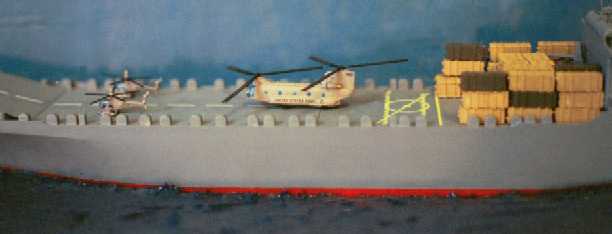
Aircraft like CH/MH-47 Chinooks and A/MH-6 Little Birds could also easily operate from Container Assault Ships
The Container Assault Ship can even defend itself from air attack by carrying its own STOVL fighter/attack aircraft. [Note we couldn't find 1/350 scale F-35 JSF models so F-18 Hornets are shown here as notional surrogates].
AmphiGavin amphibious tracked, armored fighting vehicle spearheads
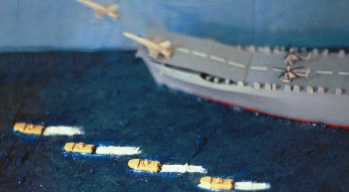
M113A4 AmphiGavins can splash into the water from RO-RO ramps and swim themselves ashore to secure beach landing sites (BLSs) for the follow-on echelons delivering non-amphibious ground vehicles
CH-53E Sky and SpeedCranes for V/TOL air delivery

A CH-53E SpeedCrane takes off from the Container Assault Ship with an AmphiGavin snug under its skeletal fuselage as a "Streamlined External Load" (SEL)
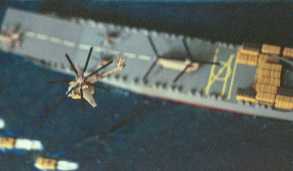
AmphiGavins can also by flown by SkyCranes/SpeedCranes over potential sea mines for 3D air assaults to secure BLSs and other mission objectives
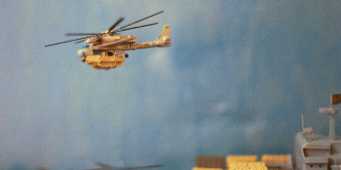
The basic CH-53E SkyCrane is fitted with Piasecki VTDP thrust units and wings can double ship-to-shore speeds making "SpeedCranes"
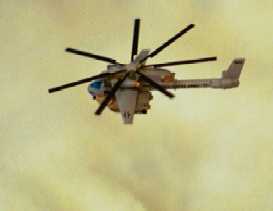
With its high 200+ mph speeds, the CH-53E SpeedCrane can fly high above the clouds to deliver cargo like M113A4 AmphiGavins and troops deep inland for 3D operational maneuver
LCAC/RO-RO Ramp Interface

Many combination container and RO-RO ships could be used as Container Assault Ships
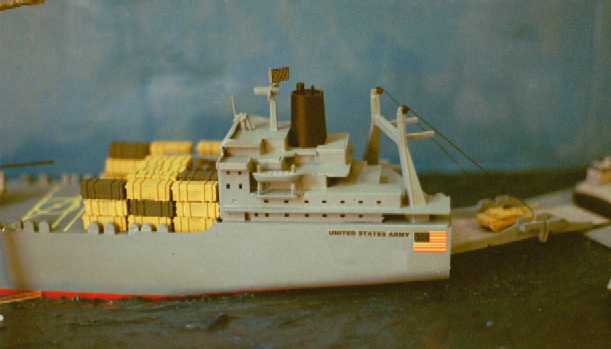
Here a container ship owned by the U.S. Army with a stern RO-RO ramp interfaces with a floating platform to enable U.S. Navy LCAC hovercraft to land and pick-up/drop-off cargo and vehicles.

This sideview shows how simultaneous actions can occur from the Container Assault Ship to speed deliveries ashore.
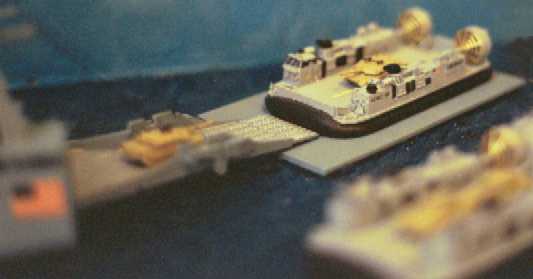
A close-up of the RO-RO ramp and LCAC landing platform
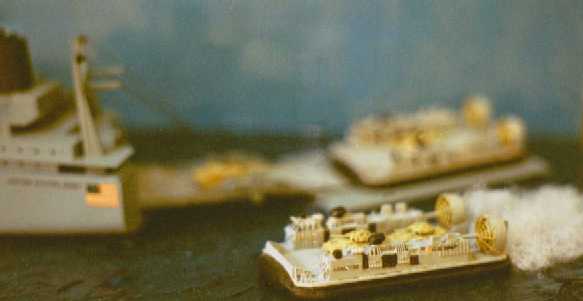
Here LCACs deliver a pair of Bradley medium Fighting Vehicles and a M1 Abrams heavy tank ashore at 60 mph speeds, over potential sea mines
Armored Resupply for the Lethal Non-Linear Battlefield (NLB)
Cargo carrying XM1108 AmphiGavins can speed cargo like ISO Container BattleBoxes ashore by swimming themselves or hitching a ride using the LCAC platform RO-RO ramp interface--restore the amphibious resupply capabilities we used to have with DUKWs in WW2 and Korea
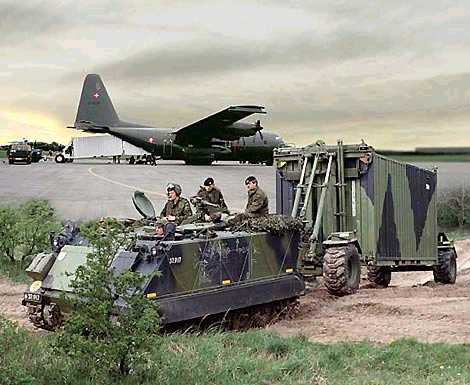
INSPIRATION FROM WORLD WAR 2 D-DAY
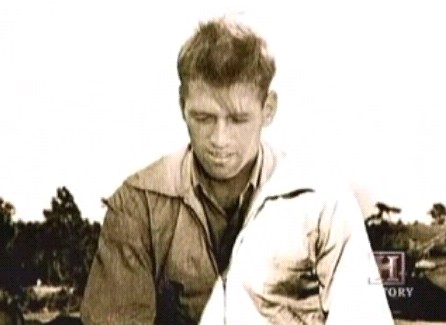
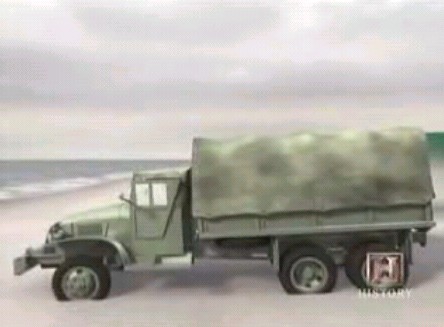
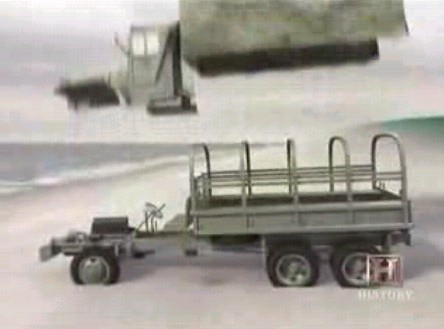
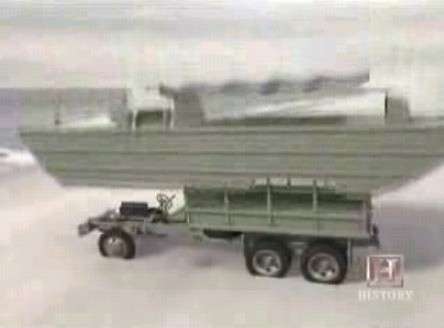
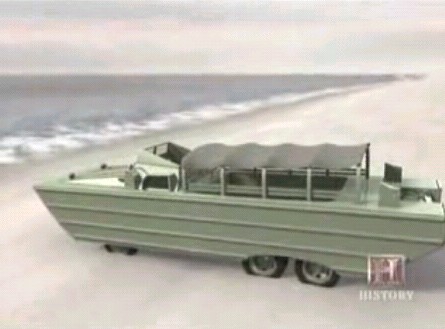
www.youtube.com/watch?v=rwox9PIDkEo
PART 4: LSTs, DUKWs, Dieppe fubar, don't attack a port directly, Mulberry port devices, huge 200 foot caisson breakwater blocks, ships sunk as breakwaters, complete LST off-load in 40 minutes by Mulberry pier instead of 6 hours on the beaches from LST, storms smash Mulberries
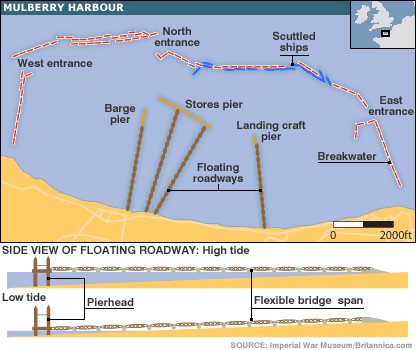
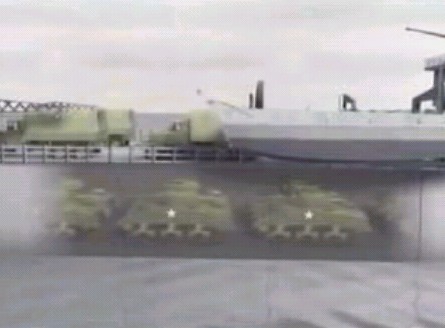
www.youtube.com/watch?v=uU1jJ0Nq1JQ
PART 5: DUKWs save the day when Mulberry harbors destroyed by rough weather, shows need for overlapping capabilities,
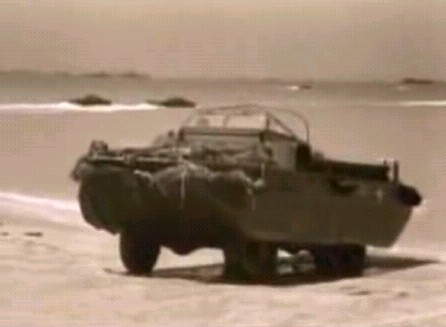
www.youtube.com/v/CtLZ3G0hRds
Ski Jumps for STOVL F-35 Lightning II Joint Strike Fighters
With the addition of a bow ski jump, Container Assault Ships can launch STOVL fighters like the F-35 JSF with full ordnance loads. The JSFs would land vertically back onto the container assault ship for refuel and rearming.

America's four Iowa class battleships, the USS Iowa, USS New Jersey, USS Missouri and USS Wisconsin should be immediately recalled to duty on a reserve status, two BBs on each coast. Iowas can transit the Panama Canal unlike our bloated supercarriers. Our BBs are the only heavily armored surface ships we have that can survive in the face of enemy surveillance strike complex (SSC) fires. If we don't want to be driven from the surface of the sea, we need to return to a "gunboat" diplomacy that has "gunboats" not floating airfields with potential victims and hostages.
Our BBs should be upgraded into "BBG-21" configuration with two long flight decks and ski jumps to operate F-35B STOVL aircraft to provide their own air cover as well as insert/extract SOF commandos using GRIER pods.
To deliver better combat power than just foot sloggers, heavy lift helicopters like the CH-53E/K Super Stallion and CH-47F Chinook can deliver both Mini-Gavins which are reduced in size to roll-on/off from the former's rear ramps and AmphiGavins full-size using external sling loading or if they are Mini-AmphiGavins from inside.
MINI-GAVINS
The Mini-Gavin is a superior American version of the German Wiesel concept of a helicopter air-transportable tracked AFV in that its lake/river amphibious and uses proven M113 components.
The Iowa class rear deck area is very spacious as-is to operate even large heavy lift helicopters. It will be even larger with BBG-21 mods.
AMPHIGAVINS
The regular sized or mini- sized M113 Gavin can be made into the ARIS SPA waterjet and nose equipped "AmphiGavin" that can swim from ship-to-shore in oceans. In the following pictures we show AmphiGavins loading into heavy lift helicopters which can drop them off into the water to swim the rest of the way to shore or take them inland themselves. Keeping the enemy guessing and unable to react by having many deployment options is the epitome of "maneuver warfare". A stern ramp could be developed so AmphiGavins could drive into the water from the Iowa class BBG-21 to swim to shore.
SPEEDCRANE
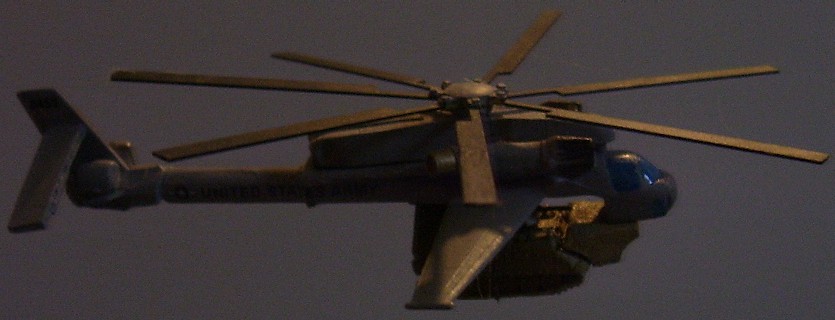
The sad truth is that conventional helicopters do not fly fast enough to survive on the increasingly missile dominated non-linear battlefield (NLB). Its high time that particularly U.S. Army Aviation wake up and stop making c'est la guerre excuses for their constant failures to improve their V/STOL flight capabilities has resulted in preventable shoot-downs and death over Iraq/Afghanistan. A great place to start would be with buying a batch of 50 x Erickson AirCrane helicopters and modifying them to be "SpeedCranes" to fly at 250+ mph with 20 ton loads. Another vital improvement would be to develop "SpeedChinook" kits for our CH-47 helicopters so they can not only air-mech Mini-Gavins faster but can deliver troops to pre-positioned shipping sets at sea to expedite their off-loading.
Conclusion
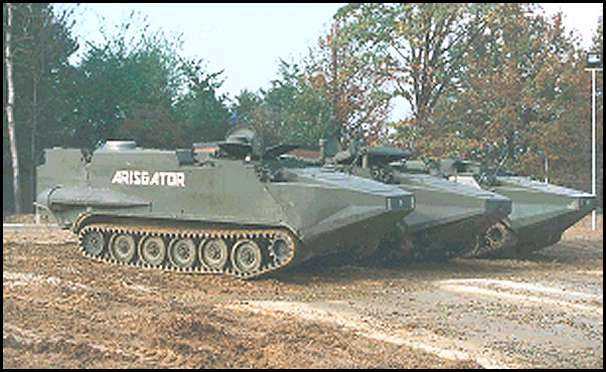
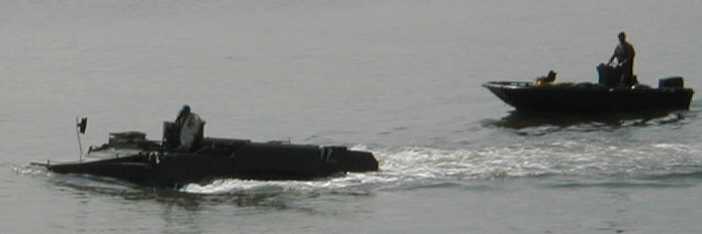
The possibilities an ocean-swim capable M113A3 AmphiGavin provide are exciting and only limited by your imagination to achieve surprise over the enemy.
Whether the force the regional CINC deploys is based around the M113A3 AmphiGavins or around M1/M2s supported by AmphiGavins, the Light Mech Sapper Company (Amphibious) will lead the way, swimming their vehicles ashore and using their combat engineering skills with organic mobility to cross lakes, rivers in full confidence so our Army can bridge and continue to fire and maneuver even in the face of enemy resistance as was done long ago in Normandy. Moving forward inland, they could meet up with their LMSC (Airborne) brethren who parachuted in, holding the assault landing zone so the M1/M2 Brigade's personnel can be flown in to link up with their vehicles brought ashore by landing craft--a seamless, low-cost, do-able Amphibious-Airborne power projection and 2D/3D decisive maneuver capability for the U.S. Army.
1st Tactical Studies Group (Airborne)
Notes
1. Air-Mech-Strike
www.geocities.com/air_mech_strike/amsbook.htm
2. Army Science Board 1999 Report; "Enabling Rapid and Decisive Strategic Maneuver for the Army After 2010"
www.google.com/search?q=cache:2Qwpk5vzFKQC:www.lia.army.mil/ms/ausa_symp2000/symp7_maddox_asb_study.ppt+c-130+loading+lav&hl=en&ie=ISO-8859-1
3. Sealift
www.globalsecurity.org/military/systems/ship/sealift.htm
4. Bob Hope class TAKR-300 LMRS ships
www.globalsecurity.org/military/systems/ship/takr-300-unit.htm
5. ARISGATOR® (Patented)
www.arisspa.it/inglese/arisgator.htm
www.arisspa.it/img_home/arisgator/fotomare.jpg
www.arisspa.it/inglese/pdf/ARISGINGL.pdf
New, Light Amphibious Vehicle, developed and manufactured by ARIS.
ARISGATOR offers considerable performances for landing operations:
*Navigation capability even in rough sea
*Unchanged land performances with respect to standard M113 vehicle
*High reliability and low operative cost ARISGATOR is fitted with:
-Tilting bow to allow an easy access to the engine compartment
-Stern with hydraulic motors for in water propulsion
-Joystick for in water control
ing. Claudio Peretti
Commercial Executive
ARIS SpA
strada Cascina Bertola, 10
10040 Lombardore, TO
Italy
tel +39 011 9956150
fax +39 011 9956205
aris.spa@arisspa.it
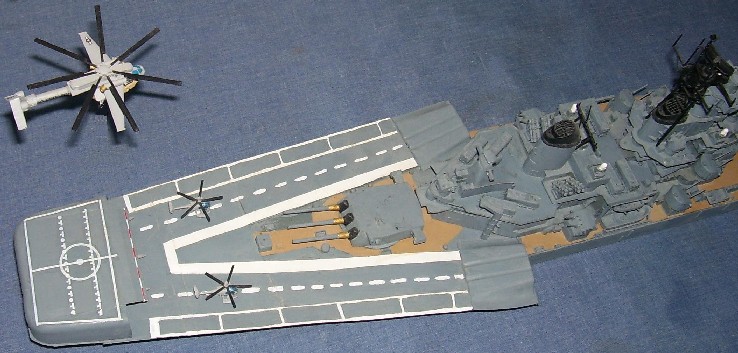
A marine writes:
"Your article is definitely a good read and puts to point the importance of the M113 amphibious version to the marine corps. The marine corps and the military higher ups in general need to start accepting the fact that large force warfare of the regimental and division size is quickly becoming non-existent, and that we need to begin focusing on making highly trained small unit forces our acting goal.
The new AAV design the marine corps is looking at bringing in is a worthless waste of funding on a vehicle that for one, cant even drive on land at a sufficient enough speed to keep up with a mechanized force on the move, but for whatever reason needs to fly at 25mph on the open ocean. We need to be focusing on our ability to move troops on the ground at faster and longer distances in vehicles that can take a hit and keep on rolling while providing an immediate indirect/direct fire supportable platform making our smaller forces more lethal to the point of making a squad just as effective as a platoon.
The 'AmphiGavin' as you put it is most certainly an option the marine corps needs to take into consideration. With the new 120mm Dragon Fire system the corps is establishing being capable of fitting into one of these vehicles, turrets with the 25mm Bushmaster cannon or this 30mm cannon you speak with the ability to Add TOW missle pods on the sides can make one of these small, light weight, highly efficient, and low maintanence tracked vehicles capable of taking either an RPG or IED attack and keep on rolling, makes the AmphiGavin the perfect troop support vehicle for amphibious operations, that transforms into a beautiful supporting fires platform once it hits the ground.
If the marine corps sticks to its plans with the CH-53K as they now call it, as its Heavy Lift option, being capable of taking two of these AmphiGavins airborne to shore, the marine corps will be set for the next 2 decades at the least.
The osprey has become something far greater then it once was, and I am a supporter of its use in future operations. It is perfect for the emphasis of small unit operations, deploying small units far in land with multiple capabilities. Many people are trying to get the corps to look else where but the corps is solid in its conceptual thoughts for its desires for the operations the osprey will be used for. We need two types of supporting helos in the corps, a heavy lift transport, and a light, fast, and multi purpose troop transport. I believe the Osprey and Ch-53K are a perfect combination for the corps.
The marine corps needs to trash this AAV-EFV behemoth and look towards the use of M113 AmphiGavins as the amphibious assault transport and ground transport and support option for the future of our Corps."
-XXX XXXXXXX 0311, Rifleman
Operation Phantom Fury Fallujah, Iraq '04' 05 and Operation Mountain Lion, Korengal Valley Afghanistan '06
